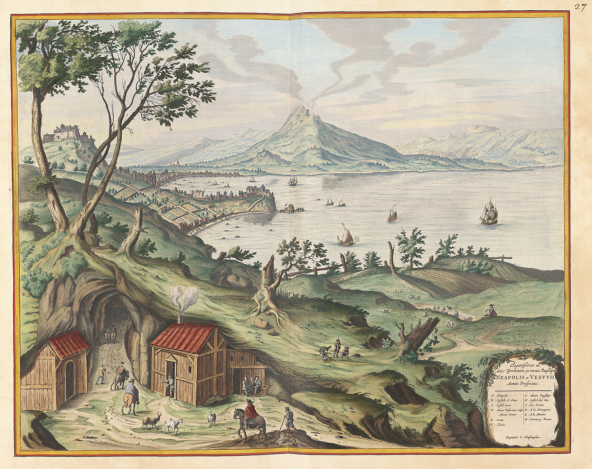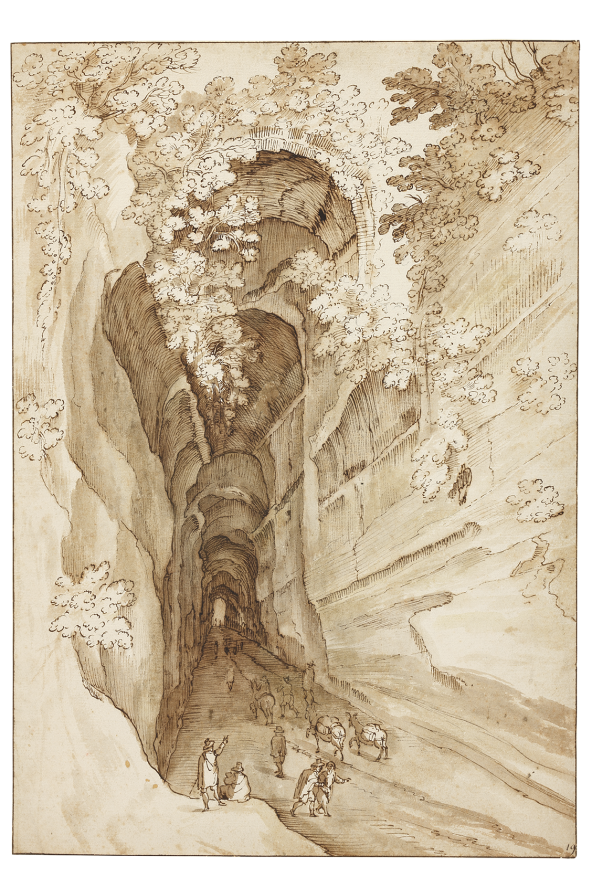Choose a background colour
Willem Schellinks, Dutch, 1627-1678: The “Grotto of Virgil” at Posillipo near Naples, c. 1664
Pen in brown ink with brown and gray wash over black chalk and graphite on paper; framing lines in brown ink.
18 1⁄4 × 13 in. (46.3 × 33 cm)
Recto, lower right, pen and brown ink, signed by the artist, W: Schellinx Fecit.; verso, lower left, in pencil, f 18:-:- de 2.
- Chain Lines:
- Vertical, 28 – 30 mm.
- Watermark:
- Strasbourg Lily with WR.
- Provenance:
Unidentified collector (stamp on backing sheet, initials JR, similar to Lugt 1521a); I. Q. van Regteren Altena, 1899 – 1980, Amsterdam (Lugt 4617, stamp on verso); thence by descent; his sale, Part I, Christie’s, London, 10 July 2014, lot 65; Sheldon and Leena Peck, Boston (Lugt 3847); gift to the Ackland Art Museum, inv. no. 2017.1.80.
- Literature/Exhibitions:
Bernt 1958, no. 538; Vienna 1964 – 65, 168, no. 336, plate 51; J. Giltaij in Rotterdam, Paris & Brussels 1976 – 77, 72, no. 122, plate 73; Brown 1977, 217, fig. 63; White & Crawley 1994, 215, under no. 328; Amsterdam 1995, 47, no. 23; P. Schatborn in Amsterdam 2001, 174 – 76, fig. F.
- Ackland Catalogue:
- 2017.1.80
Willem Schellinks was one of the most well-traveled Dutch artists of the seventeenth century, and drew numerous views in France, Switzerland, Italy, and Germany as part of an epic journey sponsored by an affluent Dutch ship-owner. This long perspectival view of a rock-hewn passageway illustrates the Grotta di Posillipo, also called the Grotto of Virgil due to the ancient poet’s supposed resting place in a tomb above the tunnel. Constructed around the first century BCE, it connected Naples to the community of Posillipo and was used daily until 1885 when modern roads replaced it. Many artists depicted the tunnel from this dramatic vantage point to show the pinpoint of light at the opposite end, confirming its tremendous length and impressive formation.
Willem Schellinks was one of the most traveled Dutch artists of the seventeenth century, a legacy that began with his voyage to France in 1646 in the company of Lambert Doomer (1624 – 1700).1
In 1661, around the age of thirty-eight, he embarked on his most substantial journey, one that took him across much of Europe over the course of four years, from England (where he spent the first two years), through France, Switzerland, Italy, Malta, and Sicily, before returning to Amsterdam through Germany.2
The trip was made possible through the financing of an affluent shipowner named Jacques Thierry, who wished Schellinks to accompany his son on a tour of Europe. This was just at the beginning of the era when the Grand Tour became customary for young men from wealthy families, though in this case the family also had business concerns in several of the coastal ports.3
Schellinks kept an extensive journal of his travels, the original manuscript of which survives in Det Kongelige Bibliotek in Copenhagen.4
Many of the numerous views Schellinks drew during this epic journey ended up in the famous Atlas Blaeu-Van der Hem, comprising fifty volumes formed by the Amsterdam collector Laurens van der Hem (1621 – 1678), and now a UNESCO Memory of the World object in the Österreichische Nationalbibliothek, Vienna.5
Van der Hem took as his starting point an edition of the Atlas Maior, the extensive cartographic masterwork of Joan Blaeu (1596 – 1673), which he then supplemented by interleaving hundreds of original drawings by various artists related to the locations therein. Schellinks contributed around 120 drawings to the Atlas, more than any other artist, though it is unclear if Van der Hem commissioned him in advance of his voyage (thereby providing additional financing) or requested copies of his views after he returned. This view in the Peck Collection is one of the few drawings by Schellinks related to the voyage that did not actually make its way into the Atlas. This could be due to the fact that Blaeu’s Atlas Maior already contained a related view showing Vesuvius from Posillipo, which shows the entrance to the tunnel at the lower left Fig. 55.1.6

After Joris Hoefnagel, View of Naples and Vesuvius from Posillipo, 1663. Etching with color and heightened with gold, bound into the Atlas Blaeu-Van der Hem, 425 × 535 mm. Vienna, Österreichische Nationalbibliothek, inv. no. 389.030-F.K 1-46, I-IV.
ÖNB/Wien/389.030-F.K-View of Naples
While far more prosaic than Schellinks’s dramatic perspectival view into the grotto, it does appear that Van der Hem was conscious about avoiding overlap. Rome, for example, is not well represented in the Atlas, but the city would have already been quite familiar to Van der Hem through other sources in his extensive collection and library.
The so-called Grotto of Virgil, better known today as the Grotta di Posillipo or Crypta Neapolitana, was for many centuries a functional tunnel connecting Naples to the community of Posillipo.7
Though closed to the public today, it lies on the old road to Pozzuoli along the Bay of Naples, and saved travelers the trouble of going the long way up and over the surrounding hills. Around 750 meters long, it was certainly a feat of engineering for the ancient era. When, exactly, it was hewn out of the rock is a matter of debate, but it was probably created sometime in the first century BCE, or perhaps first century CE. It remained in use for everyday traffic until 1885 when modern roads replaced it. In Schellinks’s day, there was a chapel carved out in the center of the tunnel in which lamps remained perpetually lit. Several accounts of the tunnel survive, both ancient and modern, nearly all of which complain about the darkness and excessive dust.8
In 1455, the King of Naples, Alfonso I (1396 – 1458) tried to ameliorate the situation by lowering the cavern floor and adding air shafts.9
Its designation as the Grotto of Virgil originated with the long-standing tradition that the tomb of the great Augustan-era poet Publius Vergilius Maro (70 – 19 bce) stood next to the tunnel.10
Ancient sources confirm that his tomb indeed rested on the road between Pozzuoli and Naples, with a famous but now-missing epitaph composed by the poet himself: “Mantua gave birth to me, the Calabrians snatched me away, Parthenope now holds me; I sang of pastures, plowlands, and leaders.“11
The presumed tomb of Virgil, of the columbarium type, still survives above the tunnel (not visible in the drawing), but it is now thought to have once belonged to an anonymous Roman family. As the resting place of the greatly admired poet, whose impact and fame over the centuries can hardly be overstated, it was no doubt a site of reverence for innumerable travelers. The same is perhaps doubly true for Schellinks, an amateur poet himself who had seen some of his verses published in anthologies in the 1650s.12
Schellinks’s handwritten description of the site in which he specifically calls it the Grotto of Virgil accompanies this drawing on a separate mount. It appears to be an extract from passages in his journal that he copied out, perhaps at the request of a patron, or because Schellinks was particularly inspired by this view. In it, he states the usual facts and legends about the tunnel and Virgil’s tomb as they were understood at the time, much of which probably came from contemporary guidebooks.
It has been noted that this drawing bears a strong compositional correspondence to an earlier drawing of the tunnel attributed to Willem van Nieulandt II (1584 – 1635) Fig. 55.2.13

Attributed to Willem van Nieulandt II, The Grotto of Posillipo near Naples. Pen in brown ink with brown wash, 404 × 280 mm. Darmstadt, Hessisches Landesmuseum, inv. no. HZ 8742.
Hessisches Landesmuseum Darmstadt. Photograph Wolfgang Fuhrmannek
Another version, weaker in execution and catalogued as Circle of Paul Bril, can be found in the British Royal Collection in Windsor.14
Both seem to copy a now-lost prototype, likely made by a Dutch or Flemish artist active in Rome around 1600 or shortly thereafter. Whether or not Schellinks was aware of one of these earlier versions is difficult to say, though it does seem likely. One can observe similarities in perspective, wall treatment, foliage, and staffage figures, and each notably contains a sketching artist perched on the knoll. The differences are nevertheless enough to cast doubt on the supposition that Schellinks largely copied another drawing rather than worked from life.15
This angle would have been one of the few possible and most appealing compositional views from which to make such a drawing, one that shows the pinpoint of light at the opposite end. Schellinks’s detailed observations also suggest an artist studying the site directly: his treatment of the stony textures of the walls and the nuanced reflections of the strong light from above using the white reserve of the paper. If he did encounter one of the previously made drawings, which perhaps informed his approach, he may have done so in Rome just before or after he passed through Naples. He was in Rome long enough to be initiated into the Bentvueghels, the association of mostly Dutch and Flemish artists there, where he was dubbed with the Bent-name Spits (peak or point).16
Whatever the case, this large and impressive view stands as one of the best surviving testimonies of Schellinks’s abilities as a draftsman.
End Notes
For the early travels through France by Schellinks and Doomer, see especially Alsteens & Buijs 2008, 70 – 189; as well as Paris & Amsterdam 2006 – 07; and Van den Berg 1942. For the life and works of Schellinks generally, see De Vries 1883; Steland 1986; P. F. M. Mens in Turner 1996; and Alsteens & Buijs 2008, 40 – 55.
Portions of these later travels have been considered in various publications; see, among others, Aikema 1983 (for travels in Italy); Exwood & Lehmann 1993 (England); P. Schatborn in Amsterdam 2001, 173 – 77 (Italy); and Dufour 2013 (specifically Sicily).
For the seventeenth-century origins of the Grand Tour among the Dutch, see Frank-van Westrienen 1983.
Inv. no. NKS 370 kvart. A photostat of the entire journal can be accessed in the RKD, The Hague (archive no. NL-HARKD.0389). An early manuscript copy of the journal can also be found in the Bodleian Library, Oxford (Catalogue of Western MSS. 1743618).
For a facsimile and study of the Atlas Blaeu-Van der Hem, see De Groot & Van der Krogt 1996 – 2008; and for an important review of the publication, Alsteens 2010. See also Schilder et al. 2011; and Amsterdam 1992.
De Groot & Van der Krogt 1996 – 2008, vol. 2 (1999), 185, no. 11:29 (f. 172 – 173).
For a history of the tunnel, with further references, see Trapp 1984, 6 – 7.
Trapp 1984, 6. See, for example, the description by the English traveler John Evelyn from 1645: “The Way is pav’d under foote; but it dus not hinder the dust, which rises so excessively in this much frequented passage, that we were forc’d at mid day, to make use of a Torch…”; De Beer 1955, 338.
Trapp 1984, 6.
Ziolkowski & Putnam 2008, 404 – 20; and Trapp 1984.
“Mantua me genuit, Calabri rapuere, tenet nunc / Parthenope; cenini pascua rura duces.” See Ziolkowski & Putnam 2008, 406.
For Schellinks’s poetry, which does not rank of great importance for modern critics, see De Vries 1883; and the transcriptions online in the DBNL (Digitale Bibliotheek voor de Nederlandse Letteren), under the name Willem Schellincx [sic]: https:// www.dbnl.org.
Darmstadt 1992, 140 – 41, no. 71.
White & Crawley 1994, 215, no. 328.
See P. Schatborn in Amsterdam 2001, 176, who suggests that the present work “refers to” the drawing attributed to Van Nieulandt in Darmstadt. Schellinks was in the habit of occasionally copying drawings by other artists, especially those who had traveled to Italy before he made the trip himself, such as Jan Asselijn and Thomas Wijck; for which see Steland-Stief 1964; Steland 1986; and P. Schatborn in Amsterdam 2001, 174 – 76.
Hoogewerff 1952, 142.
